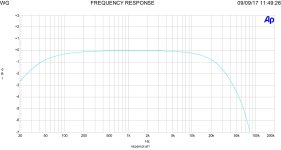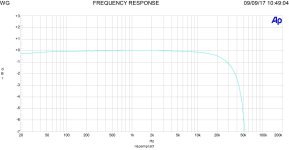Why do you need to buffer the driver? If you measure the driver in one way and use it in another then it might be a source of higher distortion than you think. From the first spectra you posted I can see that higher harmonics (from the 4th-5th apporx.) are already present at the driver at the same level of the output.
Last edited:
The circuitry is for buffering the driver tube output which stays below 0.5% THD.
The transformer output is scaled through a simple resistive divider. Neither of these should be an issue.
If you use p.e. the interface from Millett you have a good test set up to understand what happen at different level.
With Rew or Arta (with this one you can measure the inductance)
The peak you see is the resonance ( secondary open)
Before it the the andament is mai ly ( only) inductive then starting to be capacitive; at resonance the phase change immediately.
If oyy see the starting point , 10 Hz, you can see the differences on impedance of three types and the one who have a better Z has aso a lower peak of resonance .
It is always a cover that is, often too short.
More the cover is wide more the OT is expensive ( and bigger as iron)-
You can't find the same graph because they are done using a sw from my collegue at Audioreviee ( I wrote other thread about this topic)
But take maximun care on input/driver circuit.
With Fiat trafo I got (8 ohm resistive), 1 kHz
1 W con 450 mV input / 0,23% thd
8 w con 1.3 V input / 1,5 % thd
With Sowter
1w con 450 mv / 0,30% thd
8 w con 1.45v con 1.7% thd
But the response 1 watt on attached graph
Attachments
45: I can not feed the output of the driver to the soundcard because (1) the soundcard input impedance is on the order of 10K and it will excessivly load the driver, and (2) The output level of the driver (50-70Vrms) would damage the sound card.
The buffer has an input impedance in the order of 5 MEG and should not load the driver since it is already driving the 220K 300B Grid resistor.
Waltube, Millet's interface uses 400V caps in the front end. Isn't it a risk to use it on the plate of the 300B which is at 400V Plus the voltage swing due to driving it?
Looks like I have smoked one of the Gold Lions. Cathode resistors smoked, I shut power immediately when I smelled it but too late. Looks like it has a grid to cathode short now.
The buffer has an input impedance in the order of 5 MEG and should not load the driver since it is already driving the 220K 300B Grid resistor.
Waltube, Millet's interface uses 400V caps in the front end. Isn't it a risk to use it on the plate of the 300B which is at 400V Plus the voltage swing due to driving it?
Looks like I have smoked one of the Gold Lions. Cathode resistors smoked, I shut power immediately when I smelled it but too late. Looks like it has a grid to cathode short now.
Last edited:
Maybe Millett can answer at your question.
I think is the right way to check the circuit
Or you can buy a differential probe 10:1 and 100:1.
See Picotech web site
For 300B maybe a oscillation?
Or connection error?
I think is the right way to check the circuit
Or you can buy a differential probe 10:1 and 100:1.
See Picotech web site
For 300B maybe a oscillation?
Or connection error?
<snip>
Looks like I have smoked one of the Gold Lions. Cathode resistors smoked, I shut power immediately when I smelled it but too late. Looks like it has a grid to cathode short now.
Probably nothing you did wrong, I have seen this failure on EH and other Expo Pul produced 300B. The old SV300B was notorious for intermittent shorts from grid to cathode, the filament stretched and became slack and intermittently shorted to grid - very exciting.. 😈
Interesting that the grid and cathode both go to 160V, but if I remove the tube it measures open between grid and cathode.
Ah well..
Ah well..
If you don't want to spend money on other soundcards then what you can do is use a resistive load for the 12GN7 and see. Use a relatively high value for the plate resistor so you are not going to cause any cancellation. Compare it to the full amp with mu-follower. It's quite capable tube. At worst you will need to feed it with a separate supply but it's not something really difficult.45: I can not feed the output of the driver to the soundcard because (1) the soundcard input impedance is on the order of 10K and it will excessivly load the driver, and (2) The output level of the driver (50-70Vrms) would damage the sound card.
The buffer has an input impedance in the order of 5 MEG and should not load the driver since it is already driving the 220K 300B Grid resistor.
Actually you can do even simpler thing by taking the output at the plate instead of the mu-follower.
Last edited:
It's a strange fact that the measurements of Sowter not match with your measurements, I trust the Sowter more, they have a good reputation.In attach some graph already posted time ago on another thread.
All s S.E. types, similar in Z.
The Fiat is custom made for me, the Hammond is 1627SE and Sowter SA(SF)08
The test is only for trafo without output circuit
The response is, at the end, enough for all three. The THD vs, frequency is differente mainly in the low region.
The reason is in the other graph ( second post)
They are at the previous page and indeed it's the one with the lowest distortion overall. Those at post #42 are with the 300B included, I think.It's a strange fact that the measurements of Sowter not match with your measurements, I trust the Sowter more, they have a good reputation.
Verified? By whom?My test are good and verified
Bye
Walter
You had a topic here on diyaudio that was a total disaster. You didn't accept the theory from the Radiation Designers handbook.
Your transformer ideas where totally wrong, sorry to say this again.
tubes4all, waltube has access to one of the best measurement labs {audioreview magazine) you can think, with very expensive equipment that no dyier has. Apart from personal opinions (the two of us had disagreement in the past on a number of things, too), measurement procedures are quite standard and so the results are consistent.
Hi Mr. 80 mV
I have my own equipments
Are two AP + other stuff
Then the lab of Audioreview
When you will show your complete tests we can speak
Bye
Walter
I have my own equipments
Are two AP + other stuff
Then the lab of Audioreview
When you will show your complete tests we can speak
Bye
Walter
As a matter of fact Sowter has also acces to the Audio Precision equipment and they are real professionals, Walter (waltube) is not and as you can see about all the comments in those topics he started you can see that he is not understanding theory about transformers. Walter also never made any transformer himself, Sowter dos. Maybe you support him because he is also Italian as you are but i guess it would be better to look at the facts.tubes4all, waltube has access to one of the best measurement labs {audioreview magazine) you can think, with very expensive equipment that no dyier has. Apart from personal opinions (the two of us had disagreement in the past on a number of things, too), measurement procedures are quite standard and so the results are consistent.
This is unwarranted, please take your personal squabbles elsewhere and leave the rest of us alone. You are thread crapping.As a matter of fact Sowter has also acces to the Audio Precision equipment and they are real professionals, Walter (waltube) is not and as you can see about all the comments in those topics he started you can see that he is not understanding theory about transformers. Walter also never made any transformer himself, Sowter dos. Maybe you support him because he is also Italian as you are but i guess it would be better to look at the facts.
maybe he have a collaboration with fiat Roma , push only this firm...
Are years that Fiat made the trafo for me
And I pay each final stuff
It is a mutual help; the proto are done by them (following some indication ) with a beautiful Swiss machine then I measure
And some of them are not available, are made only for me
But I know Sowter since 1990 ( mr. Brian Sowter is retired few years ago after sold to OEP, I know him and is a fantastic man)
And if I need to test other stuff I will buy.
Walter
@45 can you explane what you mean with “measurement procedures are quite standard”tubes4all, waltube has access to one of the best measurement labs {audioreview magazine) you can think, with very expensive equipment that no dyier has. Apart from personal opinions (the two of us had disagreement in the past on a number of things, too), measurement procedures are quite standard and so the results are consistent.
Walter use’s a reverse measuring methode with series resistors that are not matching the output impedance of the tube. Special for distortion this is a bad way to measure.
- Home
- Amplifiers
- Tubes / Valves
- 300B with high harmonic distortion

